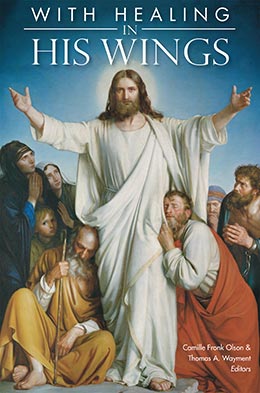Easter, the Lord’s Day
John M. Madsen
Elder John M. Madsen, “Easter, the Lord’s Day” in With Healing in His Wings, ed. Camille Fronk Olson and Thomas A. Wayment (Provo, UT: Religious Studies Center; Salt Lake City: Deseret Book, 2013), 33–53.
I am humbled and honored not only to join with you but to speak to you at this Easter Conference here on the Brigham Young University campus.
My understanding of the meaning and significance of Easter was forever changed in 1968 with the passing of our infant son James Allen, our second-born child. Right after the funeral, my wife and I were riding in the hearse with that tiny white casket before us and with loved ones and friends following behind. Suddenly, we were overwhelmed with deep and inexpressible feelings of love for our son. I reached for the tiny casket and placed it on my lap. I then released the simple hook and opened the lid, and for a few precious moments we looked upon our son in loving silence. I then reached in and took his tiny hand in mine and began to express the deep feelings of my soul, saying, “James, you hadn’t better sleep in on the morning of the Resurrection! Your mother and I will be looking for you, son!” And then, with all the love of our souls, I spoke of our determination to live the gospel of Jesus Christ in such a way as to be worthy of a glorious reunion with him on the morning of the Resurrection.
I, like each one of you, have had, and will have, many other experiences that will forever change and enhance and deepen our understanding of the meaning and supernal significance of Easter. Another such experience came for me during the Sunday morning session of general conference, held in the Tabernacle on Temple Square in April of 1996. President Gordon B. Hinckley was speaking, and he said:
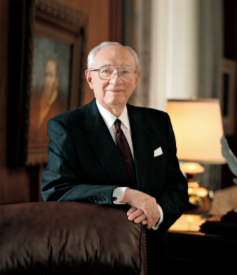 President Gordon B. Hinckley
President Gordon B. Hinckley
(© Intellectual Reserve, Inc.)
This is Easter morning. This is the Lord’s day, when we celebrate the greatest victory of all time, the victory over death. Those who hated Jesus thought they had put an end to Him forever when the cruel spikes pierced His quivering flesh and the cross was raised on Calvary. But this was the Son of God, with whose power they did not reckon. Through His death came the Resurrection and the assurance of eternal life.
President Hinckley continued:
With sorrow unspeakable those who loved Him placed His wounded, lifeless body in the new tomb of Joseph of Arimathea. Gone was the hope from the lives of His Apostles, whom He had loved and taught. He to whom they had looked as Lord and Master had been crucified and His body laid in a sealed tomb. He had taught them of His eventual death and Resurrection, but they had not understood. Now they were forlorn and dejected. . . .
The Jewish Sabbath passed. Then came a new day, a day that ever after was to be the Lord’s day. [1]
Yet again, my understanding of the meaning and supernal significance of Easter was forever changed in April of the year 2000. I was listening to the video presentation by the First Presidency and Quorum of the Twelve Apostles entitled Special Witnesses of Christ. President Gordon B. Hinckley introduced this inspiring video presentation from a balcony of the Brigham Young University Jerusalem Center for Near Eastern Studies, with the golden Dome of the Rock on the Temple Mount and the city of Jerusalem as his backdrop.
As part of his introduction, President Hinckley said, “Jerusalem was the scene of the final days of the mortal life of the Son of God. Here He suffered the agony of Gethsemane, His arrest, His trials, His condemnation, the unspeakable pain of His death on the cross, His burial in Joseph’s tomb, and the triumphant coming forth in the Resurrection.” He continued:
Now, 2,000 years have come and gone since His birth in Bethlehem. Surely this is a time for remembrance and recommitment. In our day the Lord has called 15 special witnesses to testify of His divinity before all the world. Theirs is a unique calling; they are Apostles of the Lord Jesus Christ, chosen and commissioned by Him. They have been commanded to bear witness of His living reality by the power and authority of the holy apostleship in them vested. [2]
President Hinckley explained that “these special witnesses” would “speak . . . from various locations around the earth.” [3] Then, after ten of his Brethren had spoken, President Hinckley spoke, as a special witness, standing in front of the Garden Tomb. He said:
Just outside the walls of Jerusalem, in this place or somewhere nearby, was the tomb of Joseph of Arimathea where the body of the Lord was interred. On the third day following His burial “came Mary Magdalene and the other Mary to see the sepulchre.
“And, behold, there was a great earthquake: for the angel of the Lord descended from heaven, and came and rolled back the stone from the door, and sat upon it. . . .
“And the angel . . . said unto the women, Fear not ye: for I know that ye seek Jesus, which was crucified.
“He is not here: for he is risen, as he said. [4] Come, see the place where the Lord lay” (Matt. 28:1–2, 5–6).
President Hinckley then said: “These are the most reassuring words in all of human history. Death—universal and final—had now been conquered. ‘O death, where is thy sting? O grave, where is thy victory?’ (1 Cor. 15:55). To Mary, the Risen Lord first appeared. He spoke to her, and she replied. He was real. He was alive, He whose body had been laid in death.” President Hinckley then declared: “Never had this occurred before. There had been only death without hope. Now there was life eternal. Only a God could have done this. The Resurrection of Jesus Christ was the great crowning event of His life and mission. It was the capstone of the Atonement. The sacrifice of His life for all mankind was not complete without His coming forth from the grave, with the certainty of the Resurrection for all who have walked the earth.”
President Hinckley continued:
Of all the victories in the chronicles of humanity, none is so great, none so universal in its effects, none so everlasting in its consequences as the victory of the crucified Lord, who came forth from the tomb that first Easter morning. . . .
All [those] who saw and heard and spoke with the Risen Lord, testified of the reality of this greatest of all miracles. His followers through the centuries lived and died in proclamation of the truth of this supernal act.
To all of these we add our testimony that He who died on Calvary’s cross arose again in wondrous splendor as the Son of God, the Master of life and death. [5]
Before continuing, I wish to briefly summarize President Hinckley’s teachings regarding Easter:
- Easter is the Lord’s day and “ever after was to be the Lord’s day.” [6]
- Easter is the celebration of the Resurrection of Jesus Christ, which “was the great crowning event of His life and mission. It was the capstone of the Atonement.” [7]
- “Through His death came the Resurrection and the assurance of eternal life.” [8]
- “The sacrifice of His life for all mankind was not complete without His coming forth from the grave, with the certainty of the Resurrection for all who have walked the earth.” [9]
- “Of all the victories in the chronicles of humanity, none is so great, none so universal in its effects, none so everlasting in its consequences as the victory of the crucified Lord, who came forth from the tomb that first Easter morning.” [10]
Regarding the Lord’s day, or the Christian Sabbath, Elder Bruce R. McConkie of the Quorum of the Twelve Apostles taught that
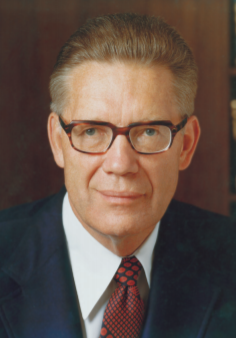 Elder Bruce R. McConkie
Elder Bruce R. McConkie
(© Intellectual Reserve, Inc.)
“Sabbath observance is an eternal principle, and the day itself is so ordained and arranged that it bears record of Christ by pointing particular attention to great works he has performed. From the day of Adam to the Exodus from Egypt, the Sabbath commemorated the fact that Christ rested from his creative labors on the 7th day. (Ex. 20:8–11.) From the Exodus to the day of his resurrection, the Sabbath commemorated the deliverance of Israel from Egyptian bondage. (Deut. 5:12–15.) . . . From the days of the early apostles to the present, the Sabbath has been the first day of the week, the Lord’s Day, in commemoration of the fact that Christ came forth from the grave on Sunday. (Acts 20:7).” [11]
Our love for and observance of the Sabbath day, or the Lord’s day, is forever changed and enhanced as we come to understand and remember that every Sunday, not only Easter Sunday, is the Lord’s day, “in commemoration of the fact that Christ came forth from the grave on Sunday.” [12]
I wish to share one other experience that had a profound effect upon me and upon my understanding of the meaning and supernal significance of Easter. Many years ago while working at Church headquarters, I noticed an announcement that Elder McConkie would be speaking in a noon devotional in the First Floor auditorium of the Church Office Building. Rather than going to lunch, I went directly to the auditorium, which quickly filled to capacity. Elder McConkie gave a powerful discourse on the consequences of the Fall, and as he concluded he asked this question, “How do you prove that Jesus is the Christ?” There was a profound silence. No one moved or offered any response. Then Elder McConkie declared, “It all centers in the Resurrection.” Elder McConkie then asked, “How do you prove the Resurrection?” Once again there was a profound silence until Elder McConkie finally declared, “It all centers in witnesses.”
This was a glorious moment for me as there, standing before us, was an Apostle of the Lord Jesus Christ, a special witness. How do you prove that Jesus is the Christ? It all centers in the Resurrection. How do you prove the Resurrection? It all centers in witnesses.
Let’s consider the first question, with some modification and additions. How did Jesus—the crucified Lord, who died on Calvary’s cross, was buried in Joseph’s tomb, and rose again the third day—prove to his Apostles and faithful disciples that He was indeed the Christ?
For an answer we turn to Luke 24, beginning with verse 33, wherein we read that the two disciples who had just beheld the Risen Lord “rose up the same hour, and returned” from the village of Emmaus “to Jerusalem, and found the . . . [Apostles] gathered together, and them that were with them.” Surely these two disciples could scarcely contain their joy or be constrained from reporting the wondrous experience they had just had with the Risen Lord (see vv. 13–32). But first, they were greeted with the glorious announcement that “the Lord is risen indeed, and hath appeared to Simon,” the Lord’s chief Apostle. And then the two disciples were permitted to tell “what things were done in the way, and how [Jesus] was known of them in breaking of bread” (vv. 33–35; emphasis added).
And as they thus spake, [now, try to imagine that you were present as] Jesus himself [suddenly appeared and] stood in the midst of them, and saith unto them, Peace be unto you.
But they were terrified and affrighted, and supposed that they had seen a spirit.
And he said unto them, Why are ye troubled? and why do thoughts arise in your hearts?
Behold my hands and my feet, that it is I myself: handle me, and see; for a spirit hath not flesh and bones, as ye see me have.
And when he had thus spoken, he shewed them his hands and his feet.
And while they yet believed not for joy, and wondered, he said unto them, Have ye here any meat?
And they gave him a piece of a broiled fish, and of an honey-comb.
And he took it, and did eat before them.
And he said unto them, These are the words which I spake unto you, while I was yet with you, that all things must be fulfilled, which were written in the law of Moses, and in the prophets, and in the psalms, concerning me. (Luke 24:36–44; emphasis added)
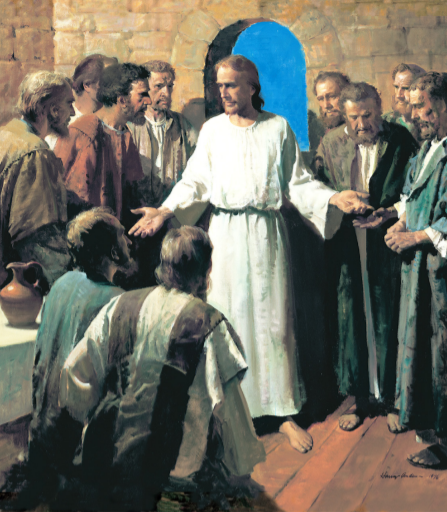 Try to imagine you were present as Jesus himself suddenly appeared and stood in the midst of the Apostles. (Harry Anderson, Feeling the Prints in His Hands, © Intellectual Reserve, Inc.)
Try to imagine you were present as Jesus himself suddenly appeared and stood in the midst of the Apostles. (Harry Anderson, Feeling the Prints in His Hands, © Intellectual Reserve, Inc.)
He said this to the disciples, some of whom had been with him almost daily for about three years. “Then opened he their understanding, that they might understand the scriptures” (v. 45) as never before and that they might see and understand who it was that was standing before them and teaching them; that they might see and understand that all things that were written in the law of Moses, and in the prophets, and in the psalms concerning Him can be simply summarized in what He, the Risen Lord Jesus Christ, was about to say to them.
And [He] said unto them, Thus it is written, and thus it behoved Christ [or thus
it was necessary for Christ] to suffer, and to rise from the dead the third day:
And that repentance and remission of sins should be preached in his [the Risen Lord’s] name among all nations, beginning at Jerusalem.
And ye are witnesses of these things. (vv. 46–48; emphasis added)
None present on that glorious and wondrous occasion could possibly misunderstand Jesus’ own words and testimony, confirming that He Himself was indeed the Christ, or that He was indeed the long-awaited and promised Messiah.
And from John 20:24, we read that “Thomas, one of the twelve, . . . was not with them when Jesus came,” on what Elder James E. Talmage calls “the evening of the Resurrection Sunday.” Elder Talmage observes that Thomas remained “unconvinced,” in spite of the “solemn testimony” of what his brethren and sisters “had seen, heard, and felt,” [13] exclaiming, “Except I shall see in his hands the print of the nails, and put my finger into the print of the nails, and thrust my hand into his side, I will not believe” (John 20:25). “A week later . . . on the next Sunday, which day of the week afterward came to be known to the Church as the ‘Lord’s Day,’” [14] the disciples again assembled, “and Thomas with them: then came Jesus, the doors being shut, and stood in the midst, and said, Peace be unto you. Then saith he to Thomas, Reach hither thy finger, and behold my hands; and reach hither thy hand, and thrust it into my side: and be not faithless, but believing” (John 20:26–27).
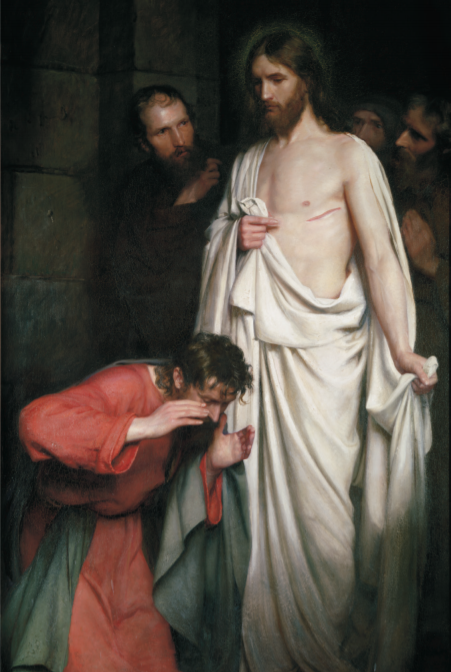 I can see in my mind’s eye Thomas, humbly reaching his hand toward the Savior’s outstretched hands and doing just as the Risen Lord had bidden him to do. (Carl Bloch, The Doubting Thomas, 1881. Courtesy of The Museum of National History on Frederiksborg Castle.)
I can see in my mind’s eye Thomas, humbly reaching his hand toward the Savior’s outstretched hands and doing just as the Risen Lord had bidden him to do. (Carl Bloch, The Doubting Thomas, 1881. Courtesy of The Museum of National History on Frederiksborg Castle.)
At that moment, I can see in my mind’s eye Thomas, humbly reaching his hand toward the Savior’s outstretched hands and doing just as the Risen Lord had bidden him to do—namely, putting his finger “into the print of the nails” and thrusting his “hand into his side.” And then “Thomas answered and said unto him, My Lord and my God” (John 20:28). How do you prove that Jesus is the Christ? It all centers in the Resurrection. How do you prove the Resurrection? It all centers in witnesses.
Just eight days after the crucified Lord came forth from the tomb, many of His faithful disciples and all of His living Apostles had seen the Risen Lord and heard Him speak and had handled or felt His resurrected body. And in so doing, they had become witnesses.
In John 20:30–31 we read, “And many other signs truly did Jesus in the presence of his disciples, which are not written in this book: but these are written that ye might believe that Jesus is the Christ, the Son of God; and that believing ye might have life through his name.”
And from the book of Acts 1:1–3 we read these words, written by Luke, “the beloved physician” (see Colossians 4:14):
The former treatise have I made . . . of all that Jesus began both to do and teach,
Until the day in which he was taken up, after that he through the Holy Ghost had given commandments unto the apostles whom he had chosen:
To whom also he shewed himself alive after his passion [or sufferings; Joseph Smith Translation] by many infallible proofs, being seen of them forty days, and speaking of the things pertaining to the kingdom of God. (emphasis added)
How did Jesus, the Risen Lord, prove to the Nephites that He was indeed the Christ? “Jesus Christ did show himself unto the people of Nephi . . . and did minister unto them” (3 Nephi 11, heading; emphasis added). And when He appeared to them and confirmed to them His identity (see 3 Nephi 11:10–12), He bade them to come unto Him and thrust their hands into His side and “feel the prints of the nails in [His] hands and in [His] feet, . . . and this they did do, going forth one by one until they had all gone forth, and did see with their eyes and did feel with their hands and did know of a surety and did bear record, that it was he, of whom it was written by the prophets, that should come” (3 Nephi 11:14–15).
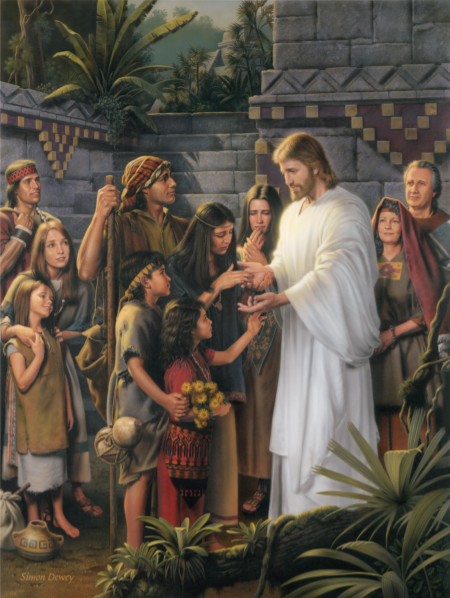 How did Jesus, the Risen Lord, prove to the Nephites that He was indeed the Christ? “Jesus Christ did show himself unto the people of Nephi . . . and did minister unto them” (3 Nephi 11). (Simon Dewey, Christ in America, 2003, © Intellectual Reserve, Inc.)
How did Jesus, the Risen Lord, prove to the Nephites that He was indeed the Christ? “Jesus Christ did show himself unto the people of Nephi . . . and did minister unto them” (3 Nephi 11). (Simon Dewey, Christ in America, 2003, © Intellectual Reserve, Inc.)
Speaking of the Resurrection of the Lord Jesus Christ, President Hinckley said:
No event of history has been more certainly confirmed. There is the testimony of all who saw and felt and spoke with the risen Lord. He appeared on two continents in two hemispheres and taught the people. . . . Two sacred volumes, two testaments speak of this most glorious of all events in all of human history. . . .
And then comes the ringing testimony of the Prophet of this dispensation that in a wondrous theophany he saw and was spoken to by the Almighty Father and the Risen Son. . . .
There is nothing more universal than death, and nothing brighter with hope and faith than the assurance of immortality. The abject sorrow that comes with death, the bereavement that follows the passing of a loved one are mitigated only by the certainty of the Resurrection of the Son of God that first Easter morning.” [15]
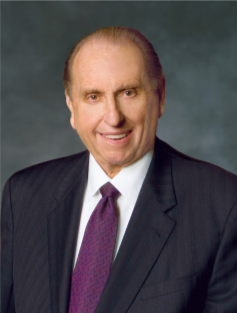 President Thomas S. Monson (© Intellectual Reserve, Inc.)
President Thomas S. Monson (© Intellectual Reserve, Inc.)
On Easter Sunday, April 4, 2010, our beloved living prophet, President Thomas S. Monson, spoke these comforting words:
The empty tomb that first Easter morning was the answer to Job’s question, “If a man die, shall he live again?” To all within the sound of my voice, I declare, if a man die, he shall live again. We know, for we have the light of revealed truth.
“For since by man came death, by man came also the resurrection of the dead.
“For as in Adam all die, even so in Christ shall all be made alive” (1 Corinthians 15:21–22).
President Monson continued:
I have read—and I believe—the testimonies of those who experienced the grief of Christ’s crucifixion and the joy of His Resurrection. I have read—and I believe—the testimonies of those in the New World who were visited by the same risen Lord.
I believe the testimony of one who, in this dispensation, spoke with the Father and the Son in a grove now called sacred and who gave his life, sealing that testimony with his blood. Declared He:
“And now, after the many testimonies which have been given of him, this is the testimony, last of all, which we give of him: That he lives!”
To conclude his address, President Monson said:
My beloved brothers and sisters, in our hour of deepest sorrow, we can receive profound peace from the words of the angel that first Easter morning: “He is not here: for he is risen” (Matt. 28:6).
He is risen! He is risen!
Tell it out with joyful voice.
He has burst his three days’ prison;
Let the whole wide earth rejoice.
Death is conquered; man is free.
Christ has won the victory!As one of His special witnesses on earth today, this glorious Easter Sunday, I declare that this is true.” [16]
I rejoice in the flood of light that flows from the scriptures and from the teachings and testimonies of prophets, seers, and revelators and special witnesses, ancient (see Acts 1:21–22; 10:40–43) and modern, who teach us of the meaning and eternal significance of Easter—the Lord’s day—and who bear witness of the divinity and living reality of the Lord Jesus Christ!
I too know and bear witness that Jesus is the Christ, the Son of the Living God. He is the Savior and Redeemer of the world. I know and bear witness that He who was crucified for the sins of the world came forth triumphant from the tomb with a body of flesh and bones on that first Easter morning. I know and bear witness that the Resurrection of the Lord Jesus Christ was the great crowning event of His life and mission and that it was the capstone of the Atonement. I know and bear witness that the Atonement is not part of the gospel—“the Atonement is the Gospel,” [17] as declared in the Doctrine and Covenants: “And this is the gospel, the glad tidings, which the voice out of the heavens bore record unto us—that he came into the world, even Jesus, to be crucified for the world, and to bear the sins of the world, and to sanctify the world, and to cleanse it from all unrighteousness; that through him all might be saved” (D&C 76:40–42).
And I know and bear witness that through the Atonement of Christ, we and all mankind, can be saved by obedience to the laws and ordinances of the gospel, including the ordinances of the holy temple, which make it possible for us not only to enjoy glorious reunions with those who have gone before but to live forever as families in the presence of God! Of these things I humbly testify in the name of Jesus Christ, amen.
Notes
[1] Gordon B. Hinckley, “This Glorious Easter Morn,” Ensign, May 1996, 66; emphasis added.
[2] Gordon B. Hinckley, in “Special Witnesses of Christ,” Ensign, April 2001, 4; emphasis added.
[3] Hinckley, in “Special Witnesses of Christ,” 4.
[4] See Matthew 16:21; 17:22–23; Luke 24:5–7; emphasis added.
[5] Hinckley, “This Glorious Easter Morn,” 66.
[6] Hinckley, in “Special Witnesses of Christ,” 14–15.
[7] Hinckley, in “Special Witnesses of Christ,” 15.
[8] Hinckley, “This Glorious Easter Morn,” 66.
[9] Hinckley, in “Special Witnesses of Christ,” 15.
[10] Hinckley, in “Special Witnesses of Christ,” 15.
[11] Bruce R. McConkie, Mormon Doctrine, 2nd ed. (Salt Lake City: Bookcraft, 1979), 658.
[12] McConkie, Mormon Doctrine, 658.
[13] James E. Talmage, Jesus the Christ (Salt Lake City: Deseret Book, 1973), 689.
[14] Talmage, Jesus the Christ, 690.
[15] Hinckley, “This Glorious Easter Morn,” 67; emphasis added.
[16] Thomas S. Monson, “He Is Risen!,” Ensign, May 2010, 89–90; emphasis added.
[17] McConkie, Mormon Doctrine, 60.
